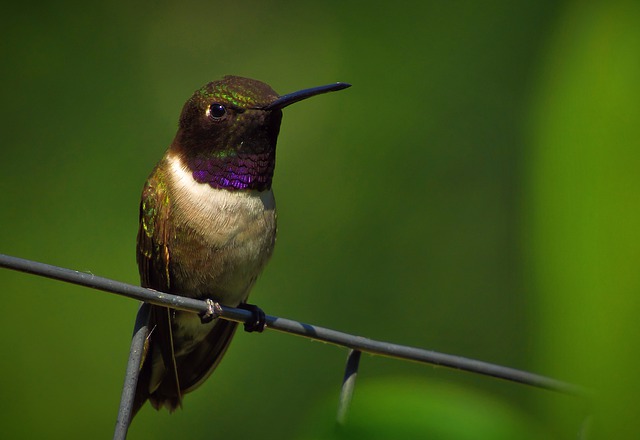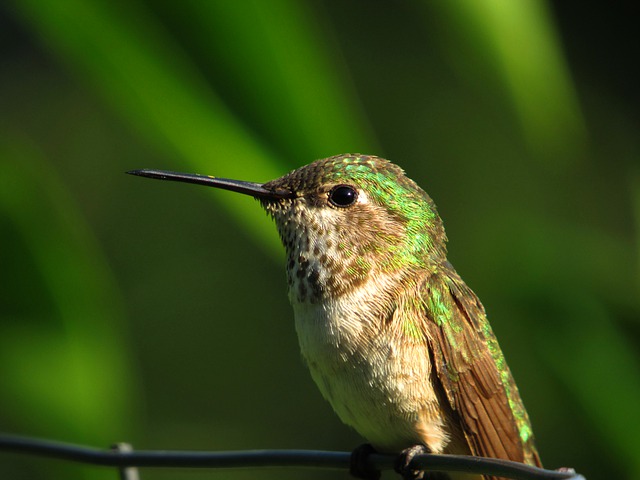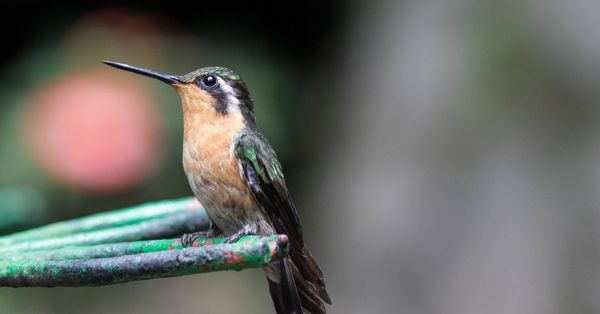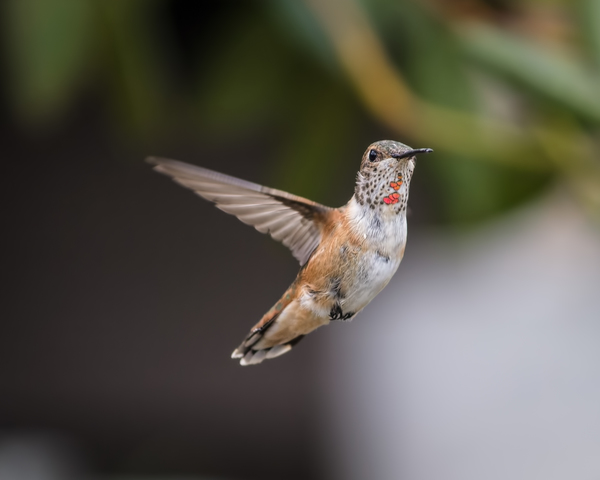Hello there, I’m excited to share with you the nine types of hummingbirds that can be found in Georgia.
These tiny and colorful birds are a delight to observe, and each species has its own unique characteristics.
Whether you’re a birdwatching enthusiast or simply curious about nature, I hope you’ll find this article informative and enjoyable.
So, let’s dive into the fascinating world of Georgia’s hummingbirds!
| Image | Name |
|---|---|
 | Ruby-Throated Hummingbird |
 | Black-Chinned Hummingbird |
 | Rufous Hummingbird |
 | Calliope Hummingbird |
 | Allen's Hummingbird |
 | Broad-Tailed Hummingbird |
 | Broad-Billed Hummingbird |
 | Buff-bellied Hummingbird |
 | Anna's Hummingbird |
Types of Hummingbirds in Georgia
1. Ruby-Throated Hummingbird

The Ruby-throated Hummingbird (Archilochus colubris) is the most abundant and widespread species of hummingbird in Georgia.
This species is a migratory bird, breeding in the northeastern United States and southeastern Canada during the summer months and then migrating south for the winter.
It is a small species with a length of around 3.5 inches and a wingspan of 4.7 inches.
The male has a bright red throat and white breasts, while the female is drabber in coloration with a green back and white underparts.
This species feeds on nectar from flowers and insects and can often be spotted hovering in midair while they feed.
2. Black-Chinned Hummingbird

The Black-chinned Hummingbird (Archilochus alexandri) is another species of hummingbird that can be found in Georgia.
This species is a non-migratory bird and can be seen year-round in the state.
The male has a dark blue-black chin and throat, while the female is mostly greenish in coloration with a white throat.
This species feeds on nectar from flowers and insects and can often be seen hovering in midair while they feed.
This species is generally smaller than the Ruby-throated Hummingbird, with a length of around 3.3 inches and a wingspan of 4.3 inches.
3. Rufous Hummingbird

The Rufous Hummingbird (Selasphorus rufus) is another species of hummingbird that can be spotted across Georgia.
This species is a migratory bird, breeding in the northwestern United States and southern Canada during the summer months and then migrating south for the winter.
The male has a bright orange-red throat and white breasts, while the female is drabber in coloration with a green back and white underparts.
This species feeds on nectar from flowers and insects and can often be spotted hovering in midair while they feed.
This species is slightly larger than the Ruby-throated Hummingbird, with a length of around 3.7 inches and a wingspan of 4.7 inches.
4. Calliope Hummingbird

The Calliope Hummingbird (Selasphorus calliope) is the smallest species of hummingbird in North America and can be found in Georgia.
This species is a migratory bird, breeding in the western United States and southwestern Canada during the summer months and then migrating south for the winter.
The male has a bright orange-red throat and white breasts, while the female is drabber in coloration with a green back and white underparts.
This species feeds on nectar from flowers and insects and can often be spotted hovering in midair while they feed.
This species is much smaller than the Ruby-throated Hummingbird, with a length of around 2.4 inches and a wingspan of 3.3 inches.
5. Allen’s Hummingbird

Though little, this fellow is very territorial, and his rufous tail, rump, and back set off his medium black beak.
Allen’s hummingbird, named for Californian bird enthusiast Charles Andrew Allen, has among the smallest mating ranges of any North American hummingbird.
Even though people have drastically changed their natural habitat, you may still see these birds flitting from feeder to feeder in the city and the suburbs.
Wild fuchsia-flowered gooseberries, bush-monkey flowers, and honeysuckle are among their favorite foods, whether foraging in the open or the woodland.
Georgia doesn’t see many of these birds, but if you’re lucky, you could see one between November and February.
6. Broad-Tailed Hummingbird

The cry of the Broad-Tailed hummingbird sounds like a string of small bells jingling and is a frequent wintertime sound.
Female Broad-tailed hummingbirds are the oldest hummingbirds in the natural population in the United States.
In addition to visiting home feeders, the Broad-Tailed hummingbird may be seen sipping nectar from a wide variety of flowering plants in open areas, woods, and woodlands.
When compared to their white chests, the males’ bright pink gorgets stand out strikingly.
This long-tailed, placid bird has a straight black beak and a kind disposition.
There are very few sightings of this hummingbird across Georgia between the months of March and November.
7. Broad-Billed Hummingbird

The male Broad-Billed hummingbird may be easily identified by its bright red bill and blue neck, which set it apart from other species of hummingbirds.
Females are gray on the bottom and top and possess a golden-greenish color.
Aside from being a common sight at bird feeders, this species may be seen getting nectar on local blooms pretty much anyplace.
The Broad-Billed hummingbird may often be seen capturing insects from plants and eating flies.
This little species has a somewhat straight, long, and notched tail. Male tails tend to be rounder and more robust than female ones.
Rarely seen in Georgia, this bird may be seen between November and March.
8. Buff-bellied Hummingbird

Because of its larger size and somewhat lengthy wings, tail, and beak, the Buff-Bellied hummingbird stands out among other species of hummingbird.
In adulthood, the bird develops a distinctive red beak with a black tip, a rufous tail, a shimmering blue-green chest and neck, a buff abdomen, and a rusty tail.
The Buff-bellied hummingbird feeds on nectar and eats insects it gleans from plants or captures in flight.
They often frighten away the smaller hummingbirds from garden feeders.
Furthermore, you may find them in urban parks containing blooming plants as well as bushland, woods, and forests.
Between the months of November and March, you could be lucky enough to see one of them in Georgia.
9. Anna’s Hummingbird

Originally from California, Anna’s hummingbird has expanded its range to the east and north in search of the exotic blooms that may be found in human gardens and fields.
Hummingbirds of the genus Anna (named after Anna Massena, Duke of Rivoli) are reported to exist in the winter on a diet of sand, ashes, and insects.
Size-wise, it falls in the middle, and its straight black bill is a telltale feature.
Males have a bright crimson gorget, and while in flight, birds of both sexes clasp their tails together.
It is possible to see Anna’s hummingbird across Georgia between the months of November and March; however, this species is as uncommon as Allen’s hummingbird.
Conclusion
In conclusion, Georgia is home to nine remarkable species of hummingbirds, each with their own unique features and behaviors.
From the sparkling Ruby-throated Hummingbird to the vibrant Rufous Hummingbird, these tiny birds are a wonder to behold.
Learning about the different types of hummingbirds in Georgia can enhance our appreciation of the natural world and inspire us to protect their habitats.
So, let us continue to enjoy the beauty of these amazing creatures and strive to preserve their existence for generations to come.
FAQ
When is the best time to see hummingbirds in Georgia?
The best time to see hummingbirds in Georgia is during the spring and fall migration periods. This is when the highest numbers of hummingbirds pass through the state.
What types of flowers attract hummingbirds in Georgia?
Hummingbirds are attracted to brightly colored flowers that are rich in nectar, such as trumpet creeper, bee balm, salvia, and cardinal flower.
Do hummingbirds migrate in Georgia?
Yes, hummingbirds do migrate through Georgia during their spring and fall migrations. Some species, such as the Ruby-throated Hummingbird, also breed in the state during the summer months.
Can I attract hummingbirds to my backyard in Georgia?
Yes, you can attract hummingbirds to your backyard in Georgia by providing a hummingbird feeder filled with a solution of four parts water to one part white granulated sugar. You can also plant nectar-rich flowers and shrubs that hummingbirds are attracted to.
How can I tell the difference between different types of hummingbirds in Georgia?
Different types of hummingbirds in Georgia can be distinguished by their size, coloration, and behavior. Field guides and online resources can also be helpful in identifying hummingbirds by their physical characteristics and geographic range.
Are hummingbirds endangered in Georgia?
While hummingbirds are not considered endangered in Georgia, their populations can be negatively affected by habitat loss and other environmental factors. It is important to protect their habitats and provide resources for their survival.
Last Updated on April 10, 2023 by Lily Aldrin
